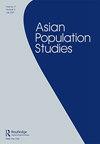中国大陆、香港和台湾地区的移民流动
IF 1.5
4区 社会学
Q2 DEMOGRAPHY
引用次数: 1
摘要
在中国大陆、香港和台湾所包围的地区,有很长的移民历史。在过去的半个世纪里,该地区的移民受到地缘政治和区域社会经济发展的影响。1949年,国民党在中国内战中战败,导致数百万人逃往香港和台湾。在接下来的几十年里,中国大陆出现了由政府发起的政治运动。1951年和1952年的三反和五反运动,1958年至1962年的大跃进,以及1966年至1976年的文化大革命,直接影响并有时停止了经济和农业生产,包括1959年至1961年的大饥荒,导致数百万人逃往香港寻求稳定(Fong et al., 2018)。随着1960年后边境的关闭,从中国大陆到香港和台湾的移民逐渐减少。近几十年来,这三个地区之间的人口迁移十分活跃。自20世纪80年代以来,中国推动经济改革,开放市场,从而吸引了台湾人来寻找机会。根据中国人口普查,2010年中国大陆约有170283名台湾居民。十年后,这一数字保持稳定,到2020年,大陆有157886名台湾居民。同样的经济机会也吸引了许多香港人在20世纪80年代和90年代移居或扩展到中国大陆。在中国大陆的香港居民人数从2010年的234,829人增加到2020年的371,380人,增长了近60%(中国国家统计局,2011,2021)。当香港和台湾的人移居到中国大陆时,许多大陆人也移居到香港和台湾。1997年香港回归中国大陆后,在接下来的15年里,超过76万人(主要是女性)从中国大陆移居到香港与家人团聚(Pong et al., 2014)。香港政府还推出了一系列招生计划,以吸引世界各地的人才,尤其是来自中国大陆的人才。“输入内地人才计划”和“资本投资者入境计划”于2003年推出,“优秀人才入境计划”则于2006年推出。最近的计划包括自2008年起实施的非本地毕业生入境安排,以及自2018年起实施的科技人才入境计划。截至2019年底,通过这些计划招募了超过26万名移民,其中相当一部分来自中国大陆(香港政府,2020)。本文章由计算机程序翻译,如有差异,请以英文原文为准。
Migration flows in the region of mainland China, Hong Kong, and Taiwan
There is a very long history of migration within the region encompassed bymainland China, Hong Kong, and Taiwan. In the last half century, migration in the region has been shaped by geopolitics and regional socioeconomic development. The defeat of the Kuomintang in China’s civil war in 1949 triggered millions of people to flee to Hong Kong and Taiwan. In the following decades, there were political campaigns initiated by the government in mainland China. The Three-anti and Five-anti Campaigns in 1951 and 1952, the Great Leap Forward from 1958 to 1962, and the Cultural Revolution from 1966 to 1976 directly affected and sometimes halted the economy and agricultural production, including the Great Famine between 1959 and 1961, led to millions of people to flee to Hong Kong in search of stability (Fong et al., 2018). With the border closing after 1960, there was gradually minimal migration from mainland China to Hong Kong and Taiwan. Migration between these three areas has flourished in recent decades. Since the 1980s, China has pushed for economic reform and opened the market, thereby attracting people from Taiwan in search of opportunities. According to the Chinese census, there were about 170,283 Taiwan residents in mainland China in 2010. The number remained steady ten years later and there were 157,886 Taiwan residents in the mainland in 2020. The same economic opportunity also attracted many people from Hong Kong who relocated or expanded to mainland China in the 1980s and 1990s. The number of Hong Kong residents in mainland China increased by nearly 60 per cent from 234,829 in 2010–371,380 in 2020 (National Bureau of Statistics of China, 2011, 2021). While people from Hong Kong and Taiwan migrated to mainland China, many from the mainland also moved to Hong Kong and Taiwan. After the return of Hong Kong to mainland China in 1997, more than 760,000 people, mainly females, moved from mainland China to Hong Kong in the next 15 years for family reunification (Pong et al., 2014). The Hong Kong government also launched a series of admission schemes to attract talent worldwide, especially from mainland China. The Admission Scheme for Mainland Talents and Professionals and the Capital Investment Entrant Scheme were introduced in 2003 and the Quality Migrant Admission Scheme was introduced in 2006. More recent schemes include the Immigration Arrangements for Non-local Graduates since 2008 and the Technology Talent Admission Scheme since 2018. By the end of 2019, over 260,000 immigrants had been recruited under these schemes and a considerable proportion of them came from mainland China (Hong Kong Government, 2020).
求助全文
通过发布文献求助,成功后即可免费获取论文全文。
去求助
来源期刊

Asian Population Studies
DEMOGRAPHY-
CiteScore
3.30
自引率
14.30%
发文量
12
期刊介绍:
The first international population journal to focus exclusively on population issues in Asia, Asian Population Studies publishes original research on matters related to population in this large, complex and rapidly changing region, and welcomes substantive empirical analyses, theoretical works, applied research, and contributions to methodology.
 求助内容:
求助内容: 应助结果提醒方式:
应助结果提醒方式:


